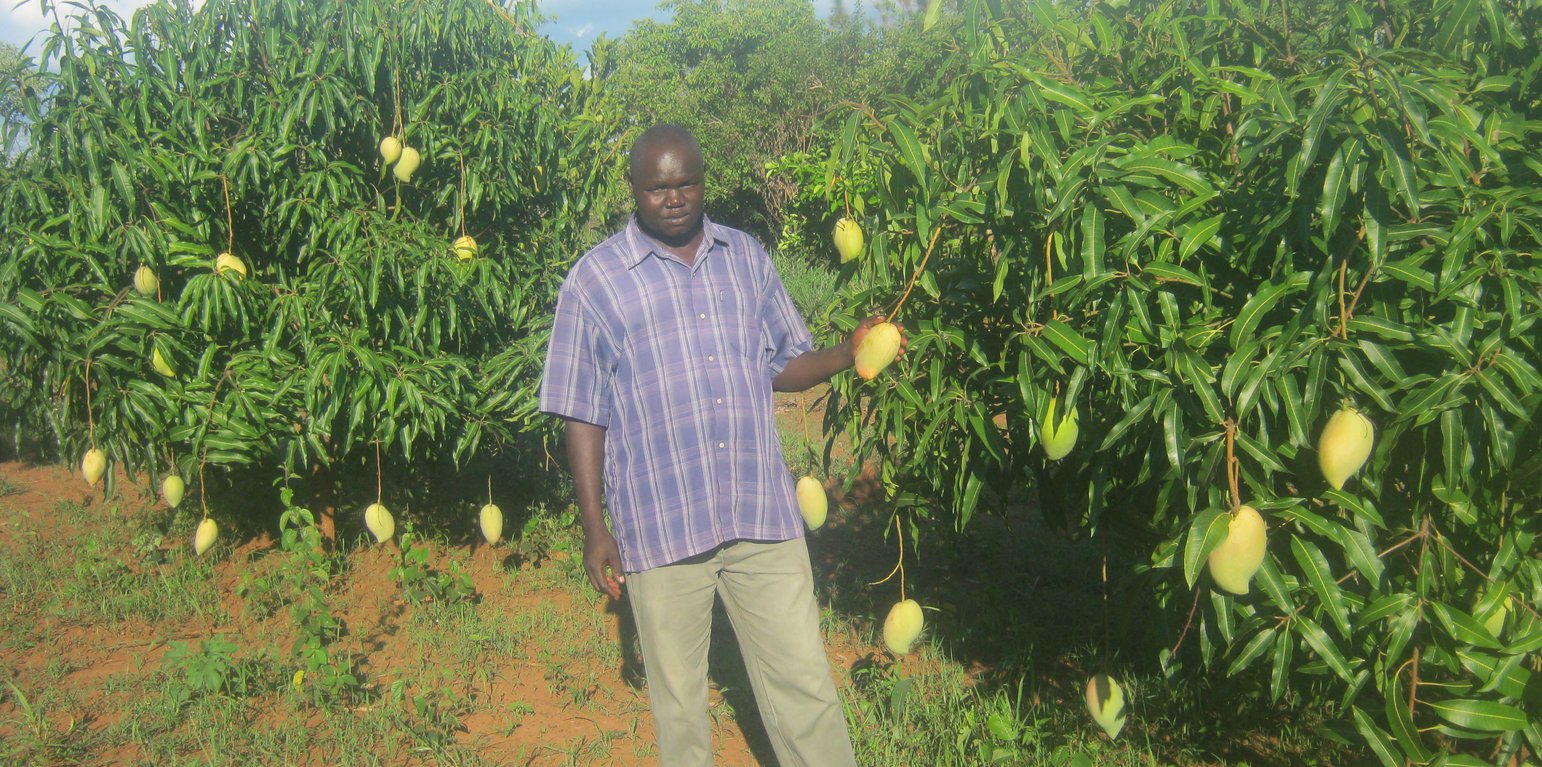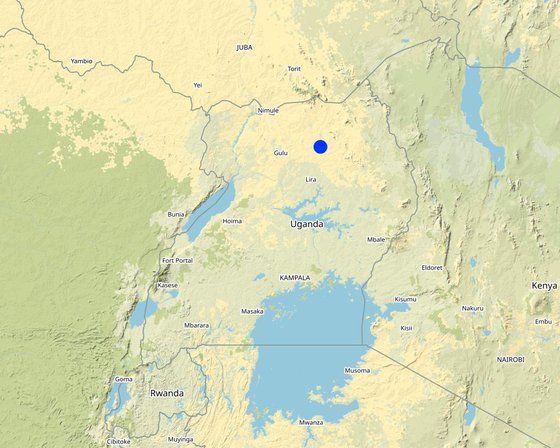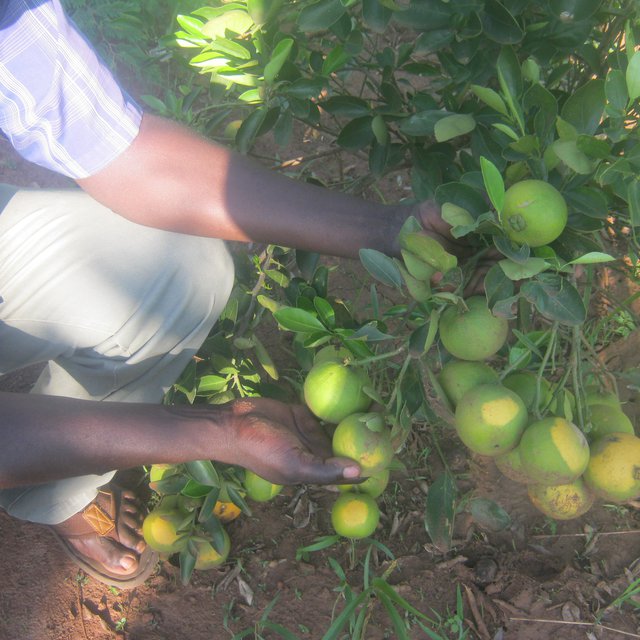



Home fruit tree groves of grafted mango (mangifera indica) and citrus (citrus aurantium) is a farming practice that farmers practice in Northern Uganda to diversify their economic activity, for soil fertility improvement and household income.
Northern Uganda has tropical savanna climate which receives moderate amount of rainfall ranging from 750-1000mm per annum. The soils are moderately fertile with less organic matters coupled with soil erosion, which leads to low crop productions hence low incomes. The moderate rainfall is also unreliable which makes the region to experience drought. Farmers grow fruits as an alternative source of income.
This land user generates over 90% of his household income from fruit growing. The planted fruit trees increase the organic matter content in the soil when dry leaves decompose, rooting prevents soil erosion, pruned brunches are a source of fuel wood and trees acts as wind breaks. Major fruits grown include jack fruits, grafted mangoes, oranges and avocados.
For all these fruits, seeds are first planted in a nursery bed for a period for about two months with the following required inputs: hoes, pangas, spades, wheelbarrows, and shovels. Afterwards, transplanting into the gardens is done. Selection and clearing of the field is done and the planting holes are marked. Excavation is done in accordance to the slope direction: the top soil is put on the hillward side of the planting hole then the sub-soil is put on the downward side of the planting hole. The planting holes are dug in a square shape at 60*60 cm. Composite manure is mixed with top soil and applied into the hole to speed up the seedling establishment and to enhance growth. When planting, the hole is not fully filled but ends 5 cm below the surface so to enable water harvesting, moisture retentions and infiltration. This ensures ample soil moisture and water supply to plants.
The spacing for avocados is 8 × 8 m (65 seedlings/acre), jack fruits is 10 × 10 m (44 seedlings/acre), mangoes 10 × 10 m (44 seedlings/acre) and oranges 4 × 5 m (200 seedlings/acre). After planting, mulching is done by saw dust, kitchen waste like groundnut husks, vegetables and so on. 75 mangoes, 150 oranges, 20 avocados, 20 jack fruits and 4 grapes trees are spread evenly over the planting area. To realize maximum production, the land user needs to have constant water for irrigation.
On the other side, fruit tree growing has brought negative feelings from neighbors who don't promote this practice. Fruit farmers' lifestyle has changed due to revenues realised from growing fruit trees. To maintain this technology, weeding, pruning and creating fire lines during dry seasons to protect the farm is very critical . The technology is highly susceptible to pests and diseases that may require support from the local extension worker from time to time to be able to obtain high yields.

ទីតាំង: Pader District, Acoro parish,Pagwari East village., Northern Uganda., អ៊ូហ្គង់ដា
ចំនួនទីកន្លែងបច្ចេកទេស ដែលវិភាគ: មួយកន្លែង
ការសាយភាយនៃបច្ចេកទេស: ត្រូវបានផ្សព្វផ្សាយត្រឹមតំបន់មួយ (approx. < 0.1 គម2 (10 ហិកតា))
កាលបរិច្ឆេទនៃការអនុវត្ត: 2013
ប្រភេទនៃការណែនាំឱ្យអនុវត្តន៍៖







លក្ខណៈបច្ចេកទេសThe fruit trees are planted on a generally flat average land size of 2 acres of land with following spacing: mangoes 10X10msq, jack fruits 10X10msq because it forms a big canopy, oranges 5X5 msq.
|
|||||||||||
| បញ្ជាក់ពីធាតុចូល | ឯកតា | បរិមាណ | ថ្លៃដើមក្នុងមួយឯកតា (UGX) | ថ្លៃធាតុចូលសរុប (UGX) | % នៃថ្លៃដើមដែលចំណាយដោយអ្នកប្រើប្រាស់ដី |
| កម្លាំងពលកម្ម | |||||
| Site clearing for nursery bed | Meters | 2,0 | 10000,0 | 20000,0 | 100,0 |
| Raising the nursery | Meters | 2,0 | 10000,0 | 20000,0 | 100,0 |
| Transplanting | Acres | 2,0 | 50000,0 | 100000,0 | 100,0 |
| Pitting for fruit tree planting | Acres | 2,0 | 50000,0 | 100000,0 | 100,0 |
| សម្ភារៈ | |||||
| Pangas | Pieces | 10,0 | 5000,0 | 50000,0 | 100,0 |
| Hoes | Pieces | 15,0 | 10000,0 | 150000,0 | 100,0 |
| Axes | Pieces | 5,0 | 10000,0 | 50000,0 | 100,0 |
| Wheelbarrows | Pieces | 4,0 | 95000,0 | 380000,0 | 100,0 |
| សម្ភារៈដាំដុះ | |||||
| String | Pieces | 4,0 | 5000,0 | 20000,0 | 100,0 |
| Dipper | Pieces | 4,0 | 45000,0 | 180000,0 | 100,0 |
| Watering can | Pieces | 2,0 | 25000,0 | 50000,0 | 100,0 |
| Spray pump | Pieces | 4,0 | 75000,0 | 300000,0 | 100,0 |
| សម្ភារៈសាងសង់ | |||||
| Bamboo | Pieces | 10,0 | 10000,0 | 100000,0 | 100,0 |
| Dry grass | Bundles | 5,0 | 3000,0 | 15000,0 | 100,0 |
| ថ្លៃដើមសរុបក្នុងការបង្កើតបច្ចេកទេស | 1'535'000.0 | ||||
| បញ្ជាក់ពីធាតុចូល | ឯកតា | បរិមាណ | ថ្លៃដើមក្នុងមួយឯកតា (UGX) | ថ្លៃធាតុចូលសរុប (UGX) | % នៃថ្លៃដើមដែលចំណាយដោយអ្នកប្រើប្រាស់ដី |
| កម្លាំងពលកម្ម | |||||
| Hired labour | Man day | 4,0 | 3000,0 | 12000,0 | 100,0 |
| សម្ភារៈ | |||||
| Spray pump | Piece | 4,0 | 75000,0 | 300000,0 | 100,0 |
| Irrigation during dry season | Litres | 10000,0 | 200,0 | 2000000,0 | 100,0 |
| Syringe pipe | Piece | 1,0 | 2500,0 | 2500,0 | 100,0 |
| សម្ភារៈដាំដុះ | |||||
| Seedings | Pieces | 269,0 | 3500,0 | 941500,0 | 100,0 |
| Composite manures | Wheelbarrows | 1,0 | 5000,0 | 5000,0 | 100,0 |
| Stringes for making holes in a stright line | Rolls | 4,0 | 5000,0 | 20000,0 | 100,0 |
| Peg for setting holes | Boundle | 1,0 | 10000,0 | 10000,0 | 100,0 |
| ជី និងសារធាតុពុល | |||||
| Pesticides (dythen m45) | kg | 1,0 | 40000,0 | 40000,0 | |
| ថ្លៃដើមសរុបសម្រាប់ការថែទាំដំណាំតាមបច្ចេកទេស | 3'331'000.0 | ||||
Due to the litter from the leaves, increased soil fertility leading to increased production.
Due to the nutrients from the soil.
Especially from the jack fruits wastes
Increased level of nutrients in the soil.
Because of the different fruit trees species planted.
The land user recently acquired additional plot of land (0.5 acres) from the sale of fruit trees.
Fruit trees reduce soil erosion and increase soil fertility due to leaves litter.
Fruit trees dont require alot of inputs once established; minimal costs for reducing pests and diseases; minimized by the role of extension workers during trainings.
From the sale of fruits and reduced expenses on farm in puts
From the sale of diverse fruit types (mangoes, oranges, jack fruits and others)
Only labour for maintenance and monitoring against thieves
Income from sale of fruits is used to buy other household income.
Daily portion of fruits within diet.
Community bye-laws on controlled grazing and encroachment were put in place.
Local bye-law committee (LBC) was put in place and supported by the Sub-County and District Council.
Bye-law on controlled grazing and encroachment passed at Sub-County Level.
Trainings conducted by extension workers and fellow champion farmers, also integrating exposure learning events.
The presence of the local bye-law committee and bye-laws reduced conflicts: no encroachment, no grazing on fruit gardens and no thieves.
Integrating people with disabilities (PWDs) in fruit tree growing trainings and exposure learning events.
Planted fruit trees control soil run off/soil erosion.
Due to vegetation litter, plant growth and reduced cutting of trees.
Due to vegetation litter, plant growth and reduced cutting of trees.
Due to planted fruit trees and soil&water conservation bye-law on tree planting.
Planted trees reduce drought.
Due to firelines to control bush burning during dry season.
Due to presence of strict community bye-laws.